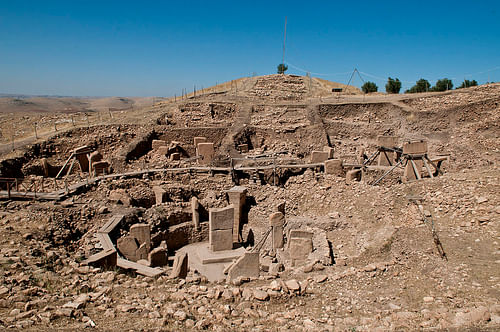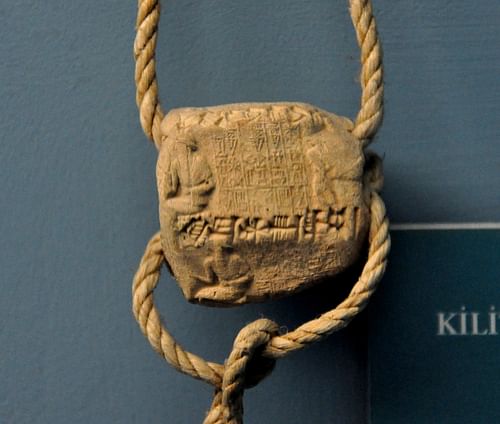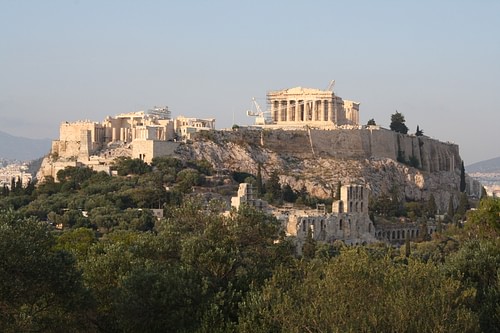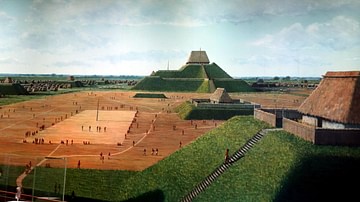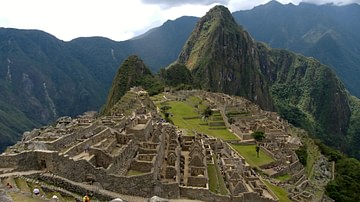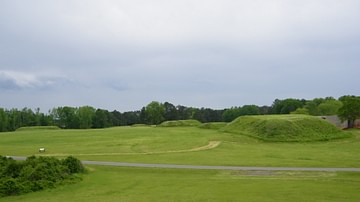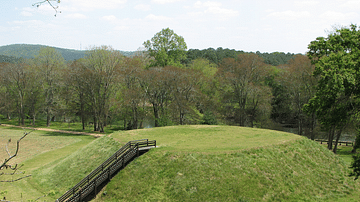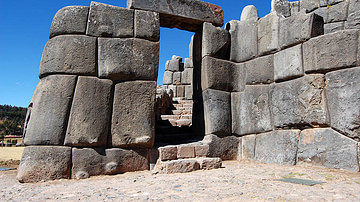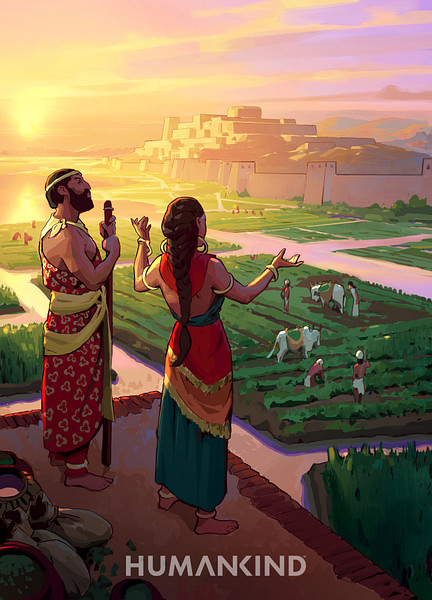
Civilization (from the Latin civis=citizen and civitas=city) is a term applied to any society which has developed a writing system, government, production of surplus food, division of labor, and urbanization. The term is difficult to define because not all 'civilizations' include every one of the above facets. The term is often used, therefore, to suggest a highly developed culture.
The first civilizations include:
- Indus Valley Civilization: c. 7000 to c. 600 BCE
- Mesopotamia's Sumerian civilization: c. 6000-1750 BCE
- Egyptian civilization: c. 6000-30 BCE
Although the Göbekli Tepe civilization (c. 10000 BCE) and China are sometimes included in this list, the above were already well-established by the time of China's prehistoric Xia Dynasty (c. 2070-1600 BCE) and its cities, while the people of Göbekli Tepe seem to have been semi-nomadic and moved on after building the site. Others, such as the Minoan, Mycenaean, and Gandhara civilizations, all formed after China's Xia Dynasty.
At the same time, China highlights the difficulty of defining 'civilization' as there were already permanent settlements (though not 'cities') along the Yellow River by 5000 BCE. Mesopotamia, as the site of the Fertile Crescent, is famously known as the 'cradle of civilization' which saw the rise of the first cities, but this designation was made prior to the identification of the Indus Valley Civilization in 1924-1925 or the discovery of Göbekli Tepe (first recorded in 1963) in 1994.
Even so, Mesopotamia is still regarded as the birthplace of civilization as the people who built Göbekli Tepe are thought to have been semi-nomadic hunter-gatherers and the Indus Valley Civilization did not begin constructing its great cities until the Mature Harappan Period (c. 2800 to c. 1900 BCE) whereas the city of Eridu in Mesopotamia was founded c. 5400 BCE and the oldest cities in Egypt date to c. 4000 BCE. The construction of cities has always been considered a primary requirement for a culture to be regarded as a civilization even if it lacks a writing system (as in the case of the Inca) which is also understood as a central civilizing attribute.
Civilizations developed from hunter-gatherers who first established semi-permanent and then permanent communities after settling into an agrarian lifestyle and began to produce surplus food. An abundance of food meant that not everyone had to work the land to eat, and so a division of labor was established with people working different jobs and purchasing food by that work, for example, potters who would sell their ceramics.
Division of labor led to the production of surplus artifacts, which, along with food, could be offered in trade to other communities. Long-distance trade, it is thought, led to the development of writing systems in maintaining business agreements. The rudimentary form of government that had worked with a small community had, by this stage, become more highly developed and centralized and usually included a religious component, leading to the construction of temples and a written body of literature concerning the gods. All of these aspects taken together are, more or less, recognized as constituting a civilization.
Concept of Civilization
The concept of 'civilization' as a state of cultural development superior to others – as the term is often used in the present day – was first developed by the Greeks. The historian Herodotus (l. c. 484-425/413 BCE) famously made the distinction between 'civilized' Greeks and 'barbarous' non-Greeks in his Histories, as noted by scholar Roger Osborne:
The word 'civilization' was first used in eighteenth-century France, but the western idea of a civilized society dates back to ancient Greece and Rome. During the classical period, Greeks began to see themselves as not just different from, but better than, other peoples. When Herodotus, writing in the mid-fifth century BCE, referred to 'the barbarians', this was really a shorthand term for non-Greeks; but by the time of Aristotle, a hundred years later, barbarians and barbarous nations could be defined by certain types of behavior – their treatment of slaves, a barter rather than money economy – that were frowned on by the civilized Greeks. Barbarians had, through their cultural habits, become lesser people than the Greeks, who were seen by themselves, and later Europeans, as the epitome of civilization. (3)
This became the prevailing view in the West and, in some scholarly and political circles, still is, but 'civilization' is no longer understood by anthropologists and scholars as a qualifying term suggesting one culture is better than another but, rather, to define what a 'mature culture' is. To this end, as noted, for a culture to be regarded as a 'civilization,' it should have developed:
- a writing system
- government
- surplus food
- division of labor
- urbanization
Of these five, urbanization is often emphasized, as a 'civilization' cannot be nomadic. The establishment of cities is a central aspect of any civilization because a sedentary community is understood as the first step in the development of any of the other aspects.
This is why, when this concept is applied to the people of the Göbekli Tepe civilization, they are not considered one of the earliest 'civilizations' because they were semi-nomadic. At a certain point c. 12000-11000 years ago, a pre-agricultural, hunter-gatherer society in the region of modern-day Turkey began forming permanent settlements and then worked together to build the structure known today as Göbekli Tepe (a modern-day designation meaning "Potbelly Hill" – the original name of the site is unknown). The purpose of Göbekli Tepe is undetermined – though most scholars believe it was a temple – as is the reason why it was buried and abandoned in antiquity.
Although this society did construct permanent housing, it seems it may have only been for the purpose of building Göbekli Tepe, and sometime after that had been accomplished, they moved on; it would be left to others to build the cities which would come to define 'civilization.'
Mesopotamia & the Rise of the City
Mesopotamia and its Fertile Crescent is known as the 'cradle of civilization' because it is understood as the first to develop the aspects one recognizes today as 'civilizing,' and this began in the region of Sumer. The term 'fertile crescent' was first coined by the Egyptologist James Henry Breasted in his 1916 work Ancient Times: A History of the Early World, where he observes:
This fertile crescent is approximately a semi-circle, with the open side toward the south, having the west end at the south-east corner of the Mediterranean, the centre directly north of Arabia, and the east end at the north end of the Persian Gulf. (193-194)
The Sumerians, who lived in the region, invented or developed all five of the criteria for a culture to be regarded as a 'civilization' following the rise of the cities as well as
- the concept of time
- long-distance trade
- domestication of animals
- mathematics and astronomy
- agricultural techniques and innovations
- religious rituals
- medical practices and texts
- astrology and the zodiac
- scientific thought and technology.
The Neolithic Age in the region (c. 7000 BCE) saw the development of animal husbandry and agriculture, which led to permanent settlements and the establishment of some rudimentary form of government and religion.
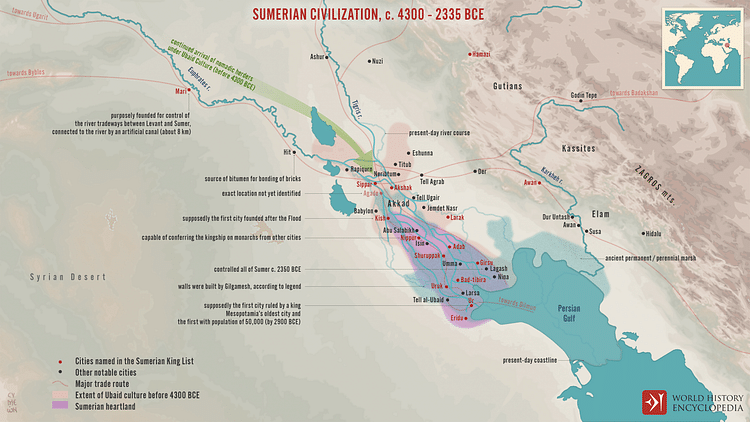
These cultural advances were furthered during the Chalcolithic Period (Copper Age, 5900-3200 BCE) and the Ubaid Period (c. 5000-4100 BCE), which gave rise to the first cities, and the urbanization process was then fully embraced during the Uruk Period (4100-2900 BCE). The earliest city cited by the Sumerians themselves is Eridu (c. 5400 BCE), although Uruk (c. 4500) and Ur (c. 3800) may have actually been inhabited earlier in some form based on archaeological evidence. By the time of the Early Bronze Age (3000-2119 BCE), Mesopotamia was "the most densely urbanized region in the ancient world" (Bertman, 201) and recognizable as a civilization. Scholar Paul Kriwaczek comments:
With the city came the centralized state, the hierarchy of social classes, the division of labour, organized religion, monumental building, civil engineering, writing, literature, sculpture, art, music, education, mathematics and law, not to mention a vast array of new inventions and discoveries, from items as basic as wheeled vehicles and sailing boats to the potter's kiln, metallurgy and the creation of synthetic materials. And on top of all that was the huge collection of notions and ideas so fundamental to our way of looking at the world, like the concept of numbers, or weight, quite independent of actual items counted or weighed – the number ten, or one kilo – that we have long forgotten that they had to be discovered or invented. (20-21)
The aspects of civilization 'discovered or invented' by the Sumerians have come to help define the term in the present day. Orientalist Samuel Noah Kramer, in his History Begins at Sumer, lists 39 'firsts' originating in the region:
- The First Schools
- The First Case of 'Apple Polishing'
- The First Case of Juvenile Delinquency
- The First 'War of Nerves'
- The First Bicameral Congress
- The First Historian
- The First Case of Tax Reduction
- The First 'Moses'
- The First Legal Precedent
- The First Pharmacopoeia
- The First 'Farmer's Almanac'
- The First Experiment in Shade-Tree Gardening
- Man's First Cosmogony and Cosmology
- The First Moral Ideals
- The First 'Job'
- The First Proverbs and Sayings
- The First Animal Fables
- The First Literary Debates
- The First Biblical Parallels
- The First 'Noah'
- The First Tale of Resurrection
- The First 'St. George'
- The First Case of Literary Borrowing
- Man's First Heroic Age
- The First Love Song
- The First Library Catalogue
- Man's First Golden Age
- The First 'Sick' Society
- The First Liturgic Laments
- The First Messiahs
- The First Long-Distance Champion
- The First Literary Imagery
- The First Sex Symbolism
- The First Mater Dolorosa
- The First Lullaby
- The First Literary Portrait
- The First Elegies
- Labor's First Victory
- The First Aquarium
Further inventions or innovations include the wheel, mass-produced bricks and ceramics, the map, the sail, possibly the dog collar, beer, the straw (used for drinking beer), cylinder seals and envelopes, epic poetry, and genres of literature.
As Kriwaczek notes, urbanization encouraged the rapid development of many aspects of civilization but had its downside as cities grew larger and natural resources diminished. Farmlands, necessary not only for produce used in trade but to feed the population, were steadily developed for housing and industry. The prosperity of the cities also drew the attention of others, who then moved against them in military campaigns of conquest. Ur, considered the largest city in the world between 2030-1980 BCE, fell to Elam c. 1750, ending the Sumerian civilization. Long before that happened, however, Ur – like many of the Mesopotamian cities – had used up its resources and was forced to import more goods from other regions. As this trend continued, the city became unsustainable and was abandoned by 450 BCE.
Other Civilizations
Urbanization – though not civilization – is understood to have spread from Mesopotamia to Egypt, but the Egyptians recognized the danger of overextending their cities. The central cultural value of ancient Egypt was ma'at – balance, harmony – ordained by the gods and personified in the goddess Ma'at. The Egyptians believed their region was the best on earth and had been given to them as a gift by the gods who had entrusted them to care for it. The Mesopotamians had a similar belief as co-workers with the gods to maintain order but had nothing comparable to the Egyptian ma'at.
The Egyptians, therefore, took greater care to control the size of their cities, preferring smaller urban centers to such a degree that historians and scholars up until the late 20th century often concluded that Egypt had no cities. The Egyptian civilization was able to avoid the fall and abandonment of cities by the specialization of urban communities. Unlike Mesopotamia, not every Egyptian city had a huge temple or industry requiring a seemingly endless supply of natural resources. Cities like Karnak and Thebes, Memphis, and Per-Ramesses were religious, political, or industrial centers, but others were maintained on a more modest scale.
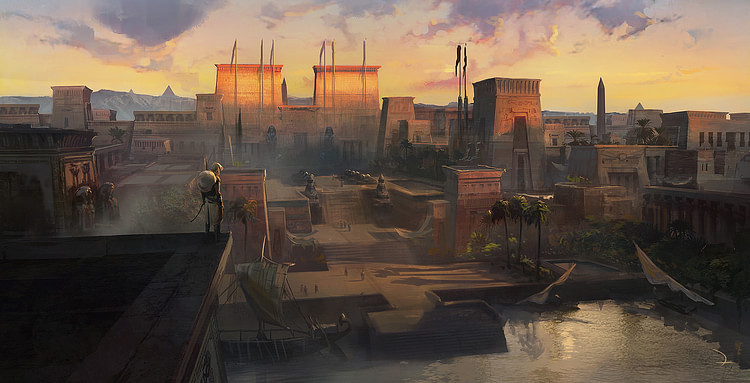
Whether Mesopotamia influenced Egyptian civilization or vice versa – or they first developed independently – continues to be debated. It is possible both were influenced by another, often overlooked, in the Levant. The Palestinian city of Jericho is recognized as the oldest in the world, dating back to 9000 BCE, and featuring the first protective walls, an aspect of urbanization that would not be seen in Mesopotamia until c. 4100 BCE and in Egypt much later.
It is also possible the development of both cultures was influenced by the Indus Valley Civilization, which had established trade with both Egypt and Mesopotamia by the Early Harappan Period (c. 5500-2800 BCE). How these people may have influenced other civilizations is difficult to determine as their writing system, the Indus script, remains undeciphered. The Indus Valley Civilization exemplifies another aspect commonly associated with 'first civilizations' – the development of permanent settlements by rivers – as seen in Mesopotamia with the Tigris and Euphrates, in Egypt with the Nile, and in China with the Yellow River.
This same paradigm holds for any civilization no matter when or where it developed as the Olmec civilization of Mesoamerica (c. 1200 to c. 400 BCE), the Maya civilization (c. 1500 BCE to c. 950 CE), and the Inca Empire (c. 1425-1532 CE) all seem to have originated near fresh water. This is hardly surprising since water is a basic necessity for human life, and prehistoric hunter-gatherers also gravitated toward water sources.
The Inca present an interesting challenge in defining 'civilization' as they never developed a writing system but were definitely a civilization. This is also true of the Moundbuilders of North America during the Archaic Period (c. 8000-1000 BCE), who had no writing system and whose cities do not seem to have conformed to the standard definition of 'city' as they were more large towns surrounded by the homes of the working class and, sometimes, a protective wall.
There is no evidence that the North Americans of Watson Brake (c. 3500 BCE) or Poverty Point (c. 1700-1100 BCE) or Moundville (c. 1100 to c. 1450) had any kind of writing system, but they were all part of the recognized civilization of North America. Cahokia (c. 600 to c. 1350) was the largest pre-Columbian city in North America, with trade established across the continent, a central government, surplus food supply, and division of labor – but no writing system. Even so, like the Inca, the indigenous peoples of North America are recognized as a civilization.
Conclusion
'Civilization' is a term that remains loosely defined, and the modern Western understanding of that term is remarkably recent. Up until the mid-19th century, no one even knew Sumer had ever existed outside of a mention in the Bible. Egyptian hieroglyphics and Mesopotamian cuneiform were not deciphered until the 1820s and 1850s, respectively, and the Indus Valley Civilization's city of Harappa was only discovered in 1829 and left unexcavated and undefined until 1924-1925. Prior to these advances, Western scholars considered Greece the 'cradle of civilization' whose culture was adapted and developed by Rome, but, in reality, Greece and Rome were latecomers in the development of civilization.
Many civilizations went unrecognized up through the 20th century, such as the African Kingdom of Zimbabwe, whose capital, Great Zimbabwe (c. 1100 to c. 1550), is understood today as an architectural masterpiece. The West African kingdoms, including the Yoruba with their capital at Ife (founded c. 500), were also ignored as they did not conform to the definition of 'civilization' as it was understood at the time. As more information has come to light, and long-held nationalistic and racialist narratives have been rejected, the definition of 'civilization' has changed and become far more inclusive. The five essential facets defining a civilization in the present day will most likely be modified and revised in the next 100 years as they have already been challenged and continue to be.
